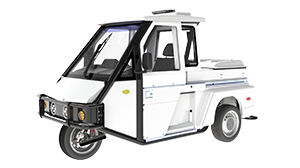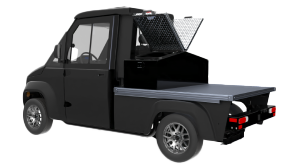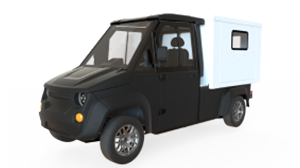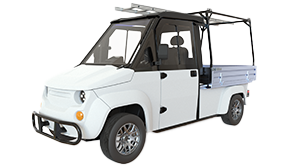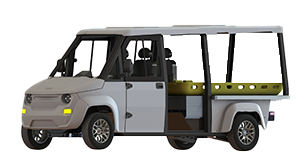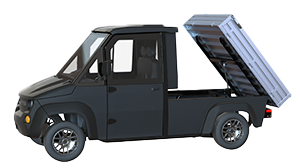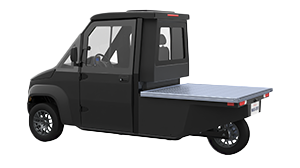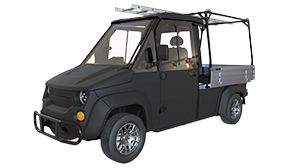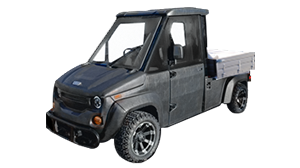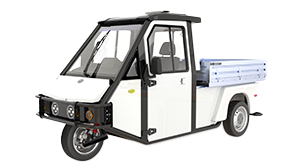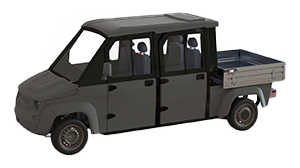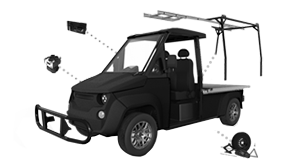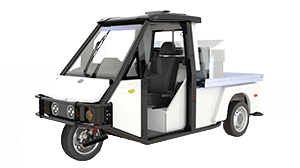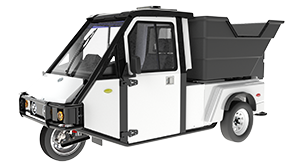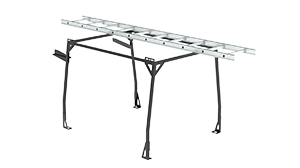Navigating the complexities of narrow streets in congested urban environments requires more than just a compact vehicle; it necessitates a thoughtful approach to design that prioritizes agility and efficiency. Westward Vehicles has meticulously crafted their electric utility vehicles to meet these demands, leveraging advanced engineering to ensure optimal performance in tight spaces. Unlike traditional vehicles, which often struggle with the intricacies of urban landscapes, our electric utility vehicles excel due to their unique design and innovative features. This focus not only enhances operational efficiency but also contributes to a more sustainable urban mobility solution.
The Urban Congestion Challenge
The Growing Urbanization
Urbanization is accelerating at an unprecedented rate, with more than half of the world’s population now residing in cities. This rapid growth has led to increasingly dense urban environments, where space is at a premium and the infrastructure is often stretched to its limits. The traditional urban planning model, designed decades ago, is struggling to accommodate the influx of vehicles and people. This mismatch between infrastructure capacity and urban growth leads to several unique challenges:
- Limited Road Space: The available road space per vehicle is shrinking, making it difficult for traditional vehicles to navigate without causing congestion.
- Increased Demand for Parking: With more vehicles on the road, the demand for parking spaces has skyrocketed, exacerbating the already critical shortage in many cities.
- Environmental Concerns: The environmental impact of conventional vehicles, including emissions and noise pollution, has become a pressing issue in densely populated areas.
Navigational Difficulties in Urban Areas
Navigating urban areas presents a host of specific challenges that are often overlooked by industry experts who typically focus on broader mobility solutions. The intricate web of narrow streets, one-way systems, and restricted zones requires a specialized approach to vehicle design and operation. Key issues include:
- Tight Turns and Small Radii: Many urban streets are characterized by tight corners and limited turning space, posing significant difficulties for larger vehicles.
- High Traffic Density: The sheer volume of vehicles and pedestrians sharing the same space increases the likelihood of congestion and accidents.
- Frequent Stops and Starts: Urban driving often involves frequent stopping and starting, which can be particularly taxing on traditional vehicle engines and brake systems.
Westward Vehicles addresses these challenges by focusing on the specific needs of urban environments. Our electric utility vehicles, such as the GO-4, are engineered with features that directly respond to these issues. For instance:
- Compact Dimensions: Our vehicles are designed to fit easily into narrow lanes and small parking spots, reducing the need for extensive maneuvering.
- Enhanced Visibility: The design of our vehicles includes large windows and strategic mirror placements, ensuring drivers have maximum visibility to navigate crowded streets safely.
- Advanced Drivetrain Technology: The use of lithium-ion batteries not only supports a greener urban environment but also ensures that our vehicles can handle the stop-start nature of city driving with greater efficiency and less wear on components.
By addressing these unique urban challenges, Westward Vehicles’ electric utility vehicles provide a more effective and sustainable solution for navigating the congested streets of modern cities.

Westward Vehicles’ Compact Design Philosophy
Design Principles
At Westward Vehicles, the compact design of our electric utility vehicles is not merely a matter of size; it embodies a philosophy rooted in efficiency, innovation, and practicality. Our approach to design begins with a deep understanding of urban dynamics and the unique challenges faced by various industries operating within these environments. This insight drives our commitment to creating vehicles that are not just smaller, but smarter in every conceivable way.
- Efficiency in Space Utilization: Every inch of our vehicle’s design is meticulously planned to maximize interior space while minimizing the overall footprint. This allows for greater maneuverability in tight spaces without sacrificing functionality or comfort.
- Aerodynamic Optimization: Our vehicles feature streamlined designs that reduce drag, enhancing both energy efficiency and driving performance. This consideration is crucial in urban settings where stop-and-go traffic can significantly impact fuel consumption.
- Modular Design Elements: We incorporate modular components that can be easily adapted or upgraded, ensuring our vehicles can meet the evolving needs of our clients without requiring a complete redesign.
Key Features of the GO-4
The GO-4 is a prime example of how our compact design philosophy translates into tangible benefits for urban operations. This electric utility vehicle boasts several unique features that set it apart from conventional vehicles:
- Ultra-Compact Dimensions: The GO-4 is engineered to navigate the narrowest of streets and fit into the smallest of parking spaces. Its compact dimensions are particularly advantageous for parking enforcement and other urban applications where space is at a premium.
- Superior Turning Radius: With an exceptionally tight turning radius, the GO-4 can easily maneuver through congested areas and make sharp turns that larger vehicles cannot manage. This capability is crucial for tasks requiring frequent directional changes, such as patrolling and maintenance operations.
- High-Visibility Cab Design: The GO-4’s cab is designed with expansive windows and optimized mirror placements, providing unparalleled visibility for the driver. This feature significantly reduces blind spots and enhances safety in bustling urban environments.
- Robust Lithium-Ion Battery System: Equipped with advanced lithium-ion batteries, the GO-4 delivers consistent power and extended range, making it ideal for the rigors of urban driving. These batteries also contribute to the vehicle’s eco-friendliness by reducing tailpipe emissions and noise pollution.
By integrating these design principles and features, Westward Vehicles ensures that our electric utility vehicles are not only compact but also highly efficient and versatile, meeting the diverse needs of urban operations. Our commitment to innovative design sets us apart in the industry, providing solutions that are both practical and forward-thinking.
Advantages of Compact Vehicles in Urban Environments
Enhanced Maneuverability
One of the primary advantages of Westward Vehicles’ compact electric utility vehicles is their exceptional maneuverability, a crucial feature for navigating the labyrinthine streets of urban areas. Unlike traditional vehicles, which often struggle with tight turns and narrow lanes, our compact design allows for seamless navigation through even the most congested cityscapes. This enhanced maneuverability is achieved through:
- Tight Turning Radius: The GO-4’s design includes an extraordinarily tight turning radius, enabling it to make sharp turns and navigate confined spaces that would be challenging for larger vehicles.
- Agility in Traffic: The compact size and responsive handling of our vehicles allow them to weave through heavy traffic efficiently, reducing travel time and increasing productivity for tasks such as parking enforcement and urban maintenance.
Parking Efficiency
Parking is a perennial challenge in urban environments, where space is scarce and competition for available spots is fierce. The compact design of Westward Vehicles’ electric utility vehicles offers significant advantages in this area:
- Minimal Space Requirement: Our vehicles require less space to park, which is particularly beneficial in densely populated areas with limited parking availability. This feature is ideal for applications like parking enforcement, where quick and efficient parking is essential.
- Ease of Parking: The small footprint and superior visibility of the GO-4 make it easier to park in tight spots, reducing the time and effort needed to find and fit into parking spaces.
Reduced Traffic Disruption
Compact vehicles contribute to smoother traffic flow and reduced congestion, an often overlooked but critical benefit in urban settings. Larger vehicles can cause significant disruptions, especially in narrow streets and crowded areas. In contrast, our compact electric utility vehicles:
- Minimize Obstruction: Due to their smaller size, our vehicles occupy less road space, thereby minimizing obstruction to other road users. This is particularly important in scenarios where our vehicles must stop frequently, such as during parking enforcement or delivery services.
- Improved Traffic Flow: The ability to navigate tight spaces without causing bottlenecks helps maintain a steady traffic flow, reducing overall congestion and enhancing the efficiency of urban transportation systems.
Eco-Friendly Operation
The environmental benefits of compact electric vehicles are significant yet often understated. Westward Vehicles’ electric utility models are designed not only for performance but also with sustainability in mind:
- Lower Emissions: Our vehicles, powered by advanced lithium-ion batteries, produce zero tailpipe emissions, contributing to cleaner air in urban areas and reducing the overall carbon footprint.
- Reduced Noise Pollution: The quiet operation of electric vehicles compared to traditional combustion engines helps decrease noise pollution, creating a more pleasant urban environment for residents and workers alike.

Real-World Applications
Parking Enforcement
One of the most prominent and impactful uses of Westward Vehicles’ GO-4 is in the realm of parking enforcement. Urban centers across North America face constant challenges with managing parking efficiently. Traditional vehicles often fall short due to their size and lack of maneuverability. However, the GO-4’s compact design provides a distinct advantage:
- Efficient Route Coverage: The GO-4’s ability to navigate narrow streets and tight spots allows parking enforcement officers to cover more ground efficiently. This increased coverage means more effective monitoring and enforcement of parking regulations, leading to better compliance and less congestion caused by improperly parked vehicles.
- Quick Response Times: With its superior maneuverability and small footprint, the GO-4 enables rapid response to parking violations. This quick response not only improves enforcement efficiency but also serves as a deterrent to potential violators.
- Operator Comfort and Safety: The high-visibility cab design of the GO-4 ensures that officers have excellent sightlines, reducing the risk of accidents. Additionally, the ergonomic design and ease of use improve operator comfort, leading to better performance and job satisfaction.
Maintenance and Landscaping
Urban maintenance and landscaping tasks often require vehicles that can navigate confined spaces and access hard-to-reach areas. The MAX-EV and MAX-EV3, Westward Vehicles’ other models, provide the necessary versatility and compact design:
- Access to Restricted Areas: The MAX-EV3 and MAX-EV can easily enter areas that are off-limits to larger vehicles, such as pedestrian zones, narrow pathways, and congested city parks. This access allows maintenance crews to perform their duties without disturbing the public or causing traffic disruptions.
- Versatility in Operations: Whether it’s transporting tools, carrying out routine inspections, or performing landscaping tasks, the adaptable design of the MAX-EV3 and MAX-EV supports a wide range of maintenance activities. Their electric powertrains also ensure that operations are conducted with minimal noise and zero tailpipe emissions, contributing to a more pleasant urban environment.
- Sustainable Practices: Utilizing the MAX-EV3 and MAX-EV for maintenance and landscaping promotes sustainable urban management. Their zero tailpipe emission electric motors and energy-efficient performance align with green city initiatives, helping municipalities achieve their environmental goals.
Delivery and Cargo
The rise of e-commerce and the increasing demand for quick delivery services have intensified the need for efficient urban logistics solutions. Westward Vehicles’ MAX-EV offers several unique advantages for delivery and cargo applications:
- Navigating Congested Streets: The MAX-EV’s compact size allows delivery drivers to navigate through congested urban areas more efficiently than larger delivery trucks. This capability reduces delivery times and enhances customer satisfaction.
- Last-Mile Delivery: The MAX-EV excels in last-mile delivery scenarios, where the final leg of the delivery route often involves complex urban environments with limited access. Its ability to park in small spaces and make tight turns makes it perfect for delivering packages to densely populated areas.
- Cargo Capacity and Adaptability: Despite its compact size, the MAX-EV is designed to maximize cargo space, allowing for the transport of a significant number of parcels. Its modular design can be customized to meet specific delivery needs, ensuring flexibility and efficiency in various delivery contexts.
These case studies demonstrate the diverse applications and significant benefits of Westward Vehicles’ models in urban environments. From parking enforcement to maintenance and delivery, our electric utility vehicles provide practical, sustainable solutions that address the unique challenges of modern cities. By integrating these vehicles into their operations, urban centers can improve efficiency, reduce environmental impact, and enhance the quality of life for their residents.

Comparative Analysis: Compact Vehicles vs. Traditional Vehicles
Operational Costs
When evaluating the operational costs of compact electric utility vehicles like Westward Vehicles’ GO-4, MAX-3, and MAX-EV against traditional vehicles, several unique factors come into play. The cost-efficiency of these compact vehicles is a critical yet often understated advantage:
- Lower Fuel Costs: The use of electric powertrains significantly reduces fuel costs compared to traditional gasoline or diesel engines. Given the volatility of fuel prices, this consistent reduction in energy expenditure provides a substantial financial benefit.
- Reduced Maintenance Costs: Electric vehicles (EVs) have fewer moving parts than internal combustion engine vehicles, leading to lower maintenance costs. Components such as engines, transmissions, and exhaust systems, which typically require regular maintenance and replacement in traditional vehicles, are either absent or less complex in EVs.
- Longer Lifespan: The durability of lithium-ion batteries and electric motors often results in a longer lifespan for EVs. This longevity translates to better return on investment over time, as the need for vehicle replacement is reduced.
Environmental Impact
The environmental impact of compact electric utility vehicles is a significant consideration that extends beyond emissions:
- Zero Tailpipe Emissions: Unlike traditional vehicles, EVs produce zero tailpipe emissions, directly contributing to improved air quality in urban environments. This reduction in pollutants is particularly beneficial in densely populated areas where air quality is a major health concern.
- Lower Noise Pollution: Electric vehicles operate much more quietly than their combustion engine counterparts. This reduction in noise pollution enhances the quality of life in urban areas, making streets quieter and more pleasant for residents and workers.
- Sustainable Materials and Production: Westward Vehicles incorporates sustainable materials and manufacturing processes wherever possible.
Performance and Reliability
Compact electric utility vehicles are designed to excel in urban environments where traditional vehicles often fall short. Key performance and reliability aspects include:
- Consistent Performance: Electric motors provide consistent torque and power delivery, making EVs particularly well-suited for the stop-and-go nature of urban driving. This consistency improves the overall driving experience and operational efficiency.
- High Reliability: The simplicity of electric powertrains, with fewer moving parts, means there is less that can go wrong. This reliability reduces the risk of unexpected breakdowns and the associated downtime and repair costs.
By examining these often-overlooked factors, it becomes clear that compact electric utility vehicles offer numerous advantages over traditional vehicles, particularly in urban settings. Their cost-efficiency, environmental benefits, and reliable performance make them an ideal choice for a wide range of urban applications. This comparative analysis underscores the value of transitioning to compact EVs for improved urban mobility and sustainability.
Future Trends in Urban Vehicle Design
Innovations in Compact Vehicle Technology
The future of urban vehicle design is being shaped by innovations that prioritize efficiency, sustainability, and adaptability. Westward Vehicles is at the forefront of these developments, continuously enhancing the capabilities of our compact electric utility vehicles. Some emerging trends and technologies include:
- Advanced Battery Technology: The development of next-generation lithium-ion batteries is set to revolutionize the electric vehicle market. These batteries promise longer life spans, faster charging times, and higher energy densities, enabling our vehicles to operate more efficiently and cover greater distances on a single charge.
- Autonomous Driving Features: Integration of autonomous driving technologies into compact vehicles is becoming increasingly viable. Features such as automated parking, lane-keeping assistance, and traffic jam navigation can enhance the safety and convenience of urban driving, particularly in congested areas.
- Lightweight Materials: The use of advanced lightweight materials, such as carbon fiber and high-strength alloys, is reducing the weight of vehicles without compromising safety or durability. This reduction in weight improves energy efficiency and enhances vehicle performance.
Integration with Smart City Initiatives
As cities become smarter, the vehicles that operate within them must also evolve. Westward Vehicles envisions aligning our products with smart city initiatives to create more interconnected and efficient urban environments:
- Vehicle-to-Infrastructure (V2I) Communication: Future advancements could see our vehicles equipped with V2I communication capabilities, allowing them to interact with traffic signals, parking meters, and other urban infrastructure. This potential integration can optimize traffic flow, reduce congestion, and improve overall urban mobility.
- Data-Driven Urban Planning: Leveraging data collected from our electric vehicles could provide city planners with insights into traffic patterns, parking usage, and vehicle performance. Such data could inform more effective urban planning decisions and infrastructure investments.
- Enhanced Fleet Management: Advanced telematics systems may enable better fleet management for organizations using our vehicles in the future. Real-time monitoring of vehicle status, location, and performance could lead to more efficient operations and quicker response times to maintenance needs.
Stay connected with Westward Vehicles on our social media channels to keep up to date with news on our future advancements and innovations. Follow us on Facebook, and LinkedIn for the latest updates and announcements.
Conclusion
Westward Vehicles’ commitment to innovative design and sustainable practices sets us apart in the urban mobility landscape. Our compact electric utility vehicles, such as the GO-4 are specifically engineered to address the unique challenges of navigating narrow streets and congested urban environments.
By focusing on efficiency, maneuverability, and environmental impact, we offer practical solutions that enhance urban operations across various sectors. Explore the benefits of our vehicles and stay updated with our latest advancements.
